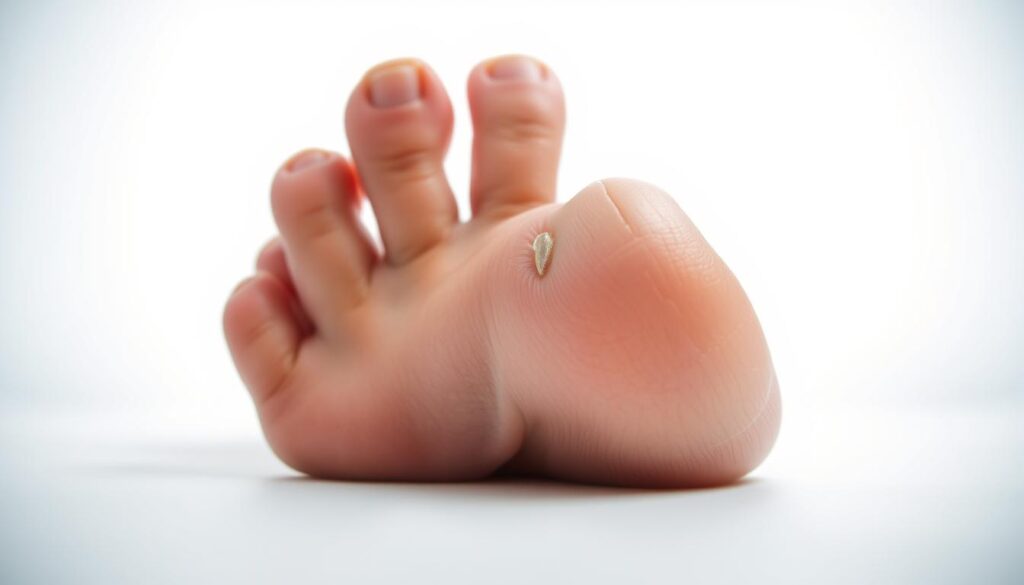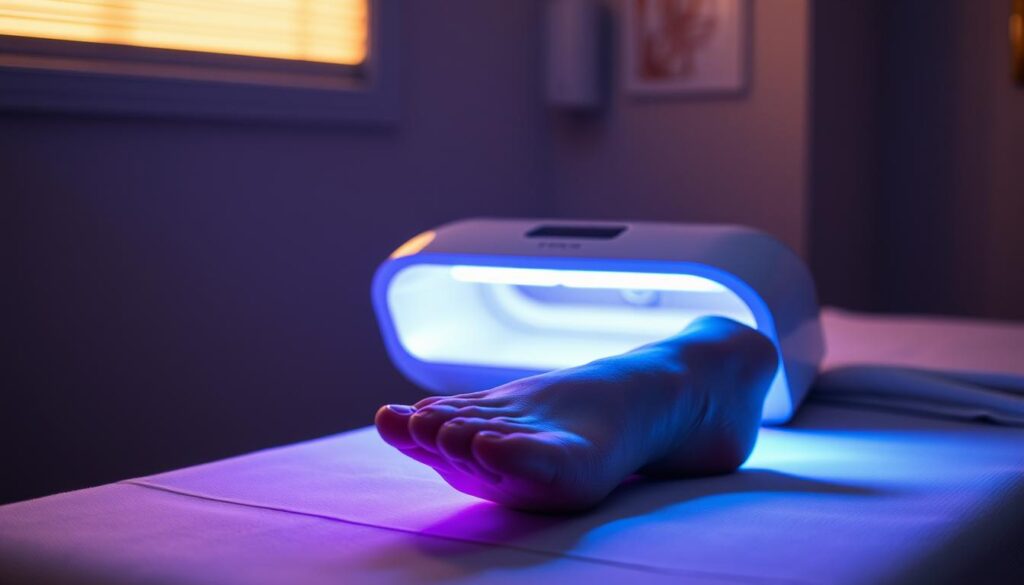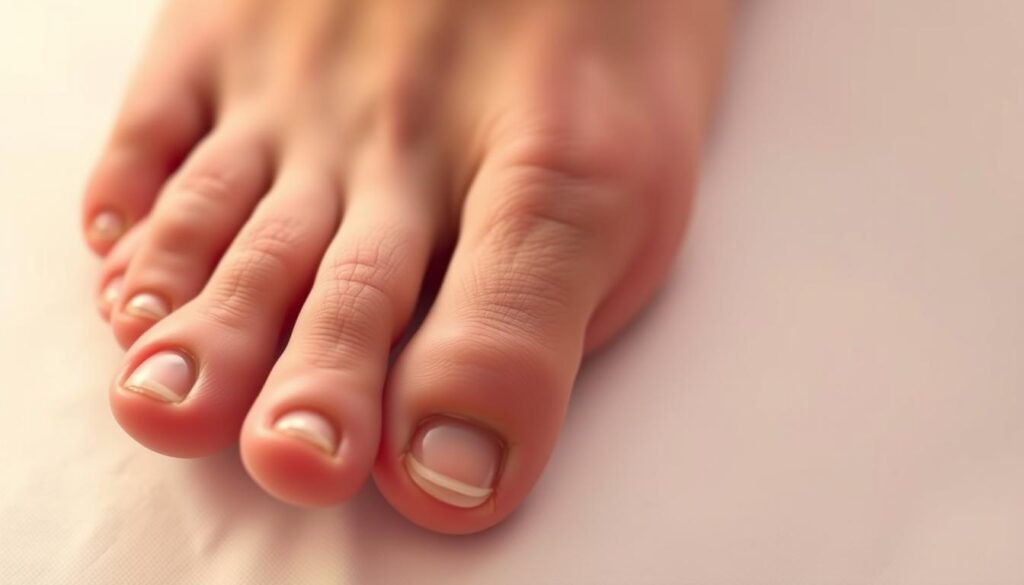Effective UV Light Treatment for Toenail Fungus | Safe & Fast Results
Contents
- 1 Understanding Toenail Fungus: Causes and Symptoms
- 2 How UV Light for Toenail Fungus Works
- 3 Benefits of Using UV Light Treatment
- 4 Safety Considerations for UV Light Therapy
- 5 Types of UV Light Devices for Home Use
- 6 Step-by-Step Guide to Using UV Light for Toenail Fungus
- 7 Clinical Evidence and Effectiveness Rates
- 8 Comparing UV Light to Other Toenail Fungus Treatments
- 9 Cost Considerations and User Experiences
- 10 Conclusion: Is UV Light Treatment Right for Your Toenail Fungus?
Are you struggling with toenail fungus and looking for a safe and effective treatment? You’re not alone. Toenail fungus is a common condition that can be challenging to treat. However, UV light therapy has emerged as a promising solution.

This non-invasive and painless treatment uses UV-C light to target the infected area, promoting healthy tissue growth and reducing the fungal load. With the availability of portable, FDA-approved devices, you can now undergo toenail fungus treatment from the comfort of your own home.
By exploring the benefits and effectiveness of UV light therapy, you can take the first step towards achieving healthy and fungus-free nails.
Understanding Toenail Fungus: Causes and Symptoms
Understanding the causes and symptoms of toenail fungus is crucial for effective treatment and prevention. Toenail fungus, medically known as onychomycosis, is a common condition that can lead to significant discomfort and aesthetic concerns if left untreated.
Common Causes of Toenail Fungus
Toenail fungus is primarily caused by dermatophytes, a type of fungi that thrives in warm, moist environments. Common causes include exposure to contaminated environments, poor foot hygiene, and wearing tight-fitting shoes that create a humid microclimate. Additionally, individuals with a history of athlete’s foot or those who have suffered nail injuries are more susceptible.
Recognizing the Symptoms
The symptoms of toenail fungus can vary, but common signs include thickening of the nail, discoloration (often yellow or white), brittleness, and in severe cases, separation of the nail from the nail bed. Recognizing these symptoms early is crucial for timely intervention.
Why Toenail Fungus Is Difficult to Treat
Toenail fungus is challenging to treat due to the fungus’s deep penetration into the nail and surrounding tissue. Traditional treatments often require prolonged use of antifungal medications, which can have varying success rates. Understanding these challenges highlights the need for effective treatment options like UV light therapy.
How UV Light for Toenail Fungus Works
UV light therapy offers a novel approach to treating toenail fungus by directly targeting the causative fungal pathogens. This method has garnered attention for its potential to provide a safe and effective treatment option.
The Science Behind UV Light Treatment
UV light treatment is based on the principle that specific wavelengths of ultraviolet light can inhibit the growth of or kill fungal cells. The therapy involves exposing the affected nail to UV light, which penetrates the nail plate to reach the infected area.
UV light’s antifungal mechanism is crucial in understanding its effectiveness. By damaging the DNA of fungal cells, UV light prevents these cells from reproducing, ultimately leading to their death.
Different Types of UV Light: UVA, UVB, and UVC
There are three primary types of UV light used in medical treatments: UVA, UVB, and UVC. Each type has different wavelengths and applications.
| Type of UV Light | Wavelength (nm) | Application |
|---|---|---|
| UVA | 320-400 | Penetrates deeper into tissues, used for various dermatological treatments |
| UVB | 290-320 | Primarily used for treating skin conditions like psoriasis |
| UVC | 100-290 | Has germicidal effects, used for disinfection purposes |
Mechanism of Action Against Fungal Cells
The mechanism by which UV light acts against fungal cells involves damaging their DNA, thereby inhibiting their ability to reproduce. For more information on alternative treatments like laser therapy, you can check out Nuvectra Medical’s review on laser toenail fungus.
This process is crucial for understanding how UV light can be an effective treatment for toenail fungus. By directly targeting the fungal infection, UV light therapy provides a promising solution for those seeking to eliminate the condition.
Benefits of Using UV Light Treatment
The use of UV light for treating toenail fungus has gained popularity due to its multiple advantages, including its non-invasive nature and fast results. This treatment modality is gaining traction among patients seeking effective solutions without the drawbacks of traditional treatments.
Ease of Use and Non-Invasive Nature
One of the primary benefits of UV light treatment is its non-invasive nature. Unlike surgical procedures or injections, UV light therapy does not require any incisions or insertion of instruments into the body, making it an attractive option for those who fear invasive medical procedures.
Speed of Results Compared to Other Treatments
UV light treatment is also noted for its ability to deliver fast results. When compared to topical antifungals or oral medications, which can take months to show significant improvement, UV light therapy can often produce noticeable results in a shorter timeframe. For a detailed comparison, consider reviewing user experiences with UV light devices.
| Treatment Method | Typical Treatment Duration | Notable Side Effects |
|---|---|---|
| UV Light Therapy | Several weeks to a few months | Rare, generally mild |
| Oral Antifungals | 3 to 6 months | Liver damage, skin rashes |
| Topical Treatments | 6 to 12 months | Skin irritation, redness |
Reduced Risk of Side Effects
Another significant advantage of UV light treatment is its reduced risk of side effects. Most patients tolerate UV light therapy well, with minimal risk of adverse reactions compared to systemic treatments like oral antifungals.

Safety Considerations for UV Light Therapy
While UV light therapy is a promising treatment for toenail fungus, it’s crucial to consider the safety aspects to ensure effective and risk-free treatment.
UV light therapy, like any other medical treatment, comes with its own set of risks and precautions. Understanding these is vital to maximizing the benefits while minimizing potential harm.
Potential Risks and Precautions
One of the primary concerns with UV light therapy is the potential for skin and eye damage due to exposure to ultraviolet light. Prolonged exposure can lead to skin burns, premature aging, and increased risk of skin cancer. To mitigate these risks, it’s essential to follow the manufacturer’s guidelines for exposure time and to wear protective eyewear during treatment.
Here are some key precautions to consider:
- Wear protective eyewear to prevent eye damage.
- Follow the recommended exposure time to avoid skin burns.
- Monitor skin condition and adjust treatment as necessary.
| Precaution | Benefit |
|---|---|
| Wear protective eyewear | Prevents eye damage |
| Follow recommended exposure time | Avoids skin burns |
| Monitor skin condition | Adjusts treatment for safety |
Who Should Avoid UV Light Treatment
Certain individuals should avoid UV light therapy due to potential health risks. These include people with a history of skin cancer, those taking photosensitizing medications, and individuals with certain medical conditions that make them more susceptible to UV damage.
It’s also important for pregnant or breastfeeding women to consult their healthcare provider before starting UV light therapy.
Types of UV Light Devices for Home Use
Several types of UV light devices are now available for individuals to treat toenail fungus in the comfort of their own homes. These devices vary in design, functionality, and effectiveness, offering users a range of options to suit their specific needs.
Choosing the right UV light device can be crucial for effective treatment. The devices come in different forms, each with its unique benefits.
Handheld UV Wands and Lamps
Handheld UV wands and lamps are popular for their convenience and ease of use. They are designed to directly target the affected toenail, providing focused UV light therapy. These devices are typically portable, making them ideal for personal use at home.
UV Shoe Sanitizers
UV shoe sanitizers not only treat toenail fungus but also sanitize the entire shoe environment. By eliminating fungi and bacteria within the shoe, these devices help prevent reinfection. They are a valuable addition to a comprehensive toenail fungus treatment regimen.
Professional-Grade UV Light Devices
For those seeking more intense treatment, professional-grade UV light devices are available for home use. These devices often offer higher intensity UV light and may include additional features such as adjustable settings and timers. While they can be more expensive, they provide a more robust treatment option for severe cases of toenail fungus.
When selecting a UV light device, it’s essential to consider factors such as the severity of the fungal infection, the device’s specifications, and user reviews. By doing so, individuals can make an informed decision and choose a device that best suits their needs.
Step-by-Step Guide to Using UV Light for Toenail Fungus
To effectively treat toenail fungus with UV light, follow a detailed guide that covers preparation, application, and scheduling. This ensures that you maximize the benefits of the treatment and achieve the best possible results.
Preparing Your Nails for Treatment
Before starting the UV light treatment, it’s essential to prepare your nails properly. Clean and dry your feet thoroughly, paying extra attention to the areas between your toes and under your nails. Trimming your toenails to keep them short can also help the UV light reach the fungus more effectively.
Proper Application Techniques
When applying UV light, ensure that the device is held at the correct distance from your toenail, as specified by the manufacturer’s instructions. Move the device slowly and steadily to cover the entire nail surface. It’s crucial to follow the recommended exposure time to avoid any potential damage.
Recommended Treatment Schedule
For optimal results, adhere to a consistent treatment schedule. Typically, treatments are recommended 2-3 times a week, but this can vary based on the device and the severity of the fungal infection. Consistency is key to effectively treating toenail fungus with UV light.
By following this step-by-step guide, you can effectively use UV light to treat toenail fungus and achieve healthier-looking nails over time.
Clinical Evidence and Effectiveness Rates
UV light therapy has emerged as a promising treatment for toenail fungus, backed by various research studies. The clinical evidence supporting its effectiveness is crucial for understanding its potential as a treatment option. Recent studies have focused on the efficacy and safety of UV light therapy for treating toenail fungus.
Research Studies on UV Light Treatment
Several research studies have investigated the effectiveness of UV light in treating toenail fungus. A notable study published in the Journal of Clinical and Aesthetic Dermatology found that UV light therapy significantly improved symptoms of toenail fungus in a majority of participants. Another study highlighted the fungicidal effects of UV light, demonstrating its ability to kill fungal cells.
Success Rates and Timeframe for Results
The success rates of UV light treatment for toenail fungus vary, but a significant number of studies report positive outcomes. On average, patients can expect to see improvements within 3 to 6 months of consistent treatment.
| Study | Success Rate | Timeframe |
|---|---|---|
| Journal of Clinical and Aesthetic Dermatology | 80% | 3 months |
| Dermatology Research and Practice | 75% | 6 months |
Comparing UV Light to Other Toenail Fungus Treatments
Comparing different treatments for toenail fungus is crucial for making an informed decision. Toenail fungus, a common condition affecting millions, can be treated through various methods, including UV light therapy, topical antifungals, oral medications, and laser treatment.
Each treatment option has its unique benefits and drawbacks. Understanding these differences is key to selecting the most appropriate treatment.
UV Light vs. Topical Antifungals
Topical antifungals are a common first-line treatment for toenail fungus. They are applied directly to the nail and surrounding area. However, their effectiveness can be limited by their ability to penetrate the nail plate. UV light treatment, on the other hand, can target the fungus more directly, potentially offering faster and more effective results.
- UV Light Advantages: Directly targets fungal cells, potentially faster results.
- Topical Antifungals Advantages: Easy to apply, non-invasive.
UV Light vs. Oral Medications
Oral medications are another treatment option for toenail fungus. They work from the inside out, attacking the fungus through the bloodstream. However, they can have significant side effects and require monitoring. In contrast, UV light treatment is generally safer and more targeted.
A comparison of the two reveals that while oral medications can be effective, UV light therapy offers a safer alternative with fewer side effects.
UV Light vs. Laser Treatment
Laser treatment is a modern approach to treating toenail fungus. It works by applying a high-intensity light beam to the affected area. While effective, it can be expensive and may require multiple sessions. UV light treatment offers a more affordable and potentially more convenient alternative.
In conclusion, when comparing UV light to other toenail fungus treatments, it’s essential to consider factors like effectiveness, safety, and convenience. UV light therapy emerges as a promising option, offering a balance of these factors.
Cost Considerations and User Experiences
When considering UV light treatment for toenail fungus, understanding the cost and user experiences is crucial. This treatment option has gained popularity due to its effectiveness and relatively low cost compared to other treatments.
Price Range for UV Light Devices
The cost of UV light devices varies widely based on the type and brand. Handheld UV wands can range from $50 to $200, while UV shoe sanitizers can cost between $20 to $100. Professional-grade devices, often used in clinics, can be more expensive, ranging from $500 to over $1,000.
- Basic handheld devices: $50-$100
- Advanced handheld devices: $100-$200
- UV shoe sanitizers: $20-$100
- Professional-grade devices: $500-$1,000+
Real User Testimonials and Results
Many users have reported positive outcomes with UV light treatment. For instance, some have seen improvements in nail clarity and reduction in fungal symptoms within a few weeks of regular use. 
Testimonials from real users highlight the convenience and effectiveness of UV light devices. Some users have shared their experiences on forums and review platforms, noting that the treatment has helped them achieve healthier-looking nails.
Conclusion: Is UV Light Treatment Right for Your Toenail Fungus?
After exploring the various aspects of UV light treatment for toenail fungus, it’s clear that this method offers a promising solution for those seeking a non-invasive and relatively fast treatment option.
The suitability of UV light treatment depends on several factors, including the severity of the fungal infection, individual health conditions, and personal preferences regarding treatment methods.
By understanding the causes and symptoms of toenail fungus, the mechanism of UV light treatment, and its benefits and safety considerations, individuals can make an informed decision about whether this treatment is right for them.
Considering the clinical evidence, user testimonials, and comparisons with other treatments, UV light therapy emerges as a viable alternative for many sufferers of toenail fungus.
Ultimately, determining the suitability of UV light treatment involves weighing its advantages against individual circumstances and potentially consulting with a healthcare professional.